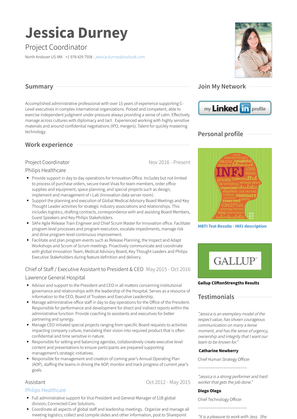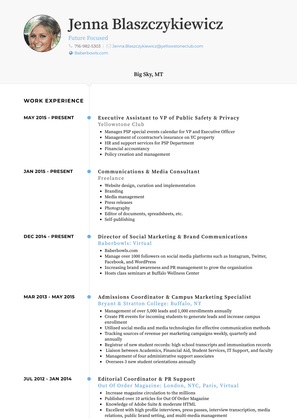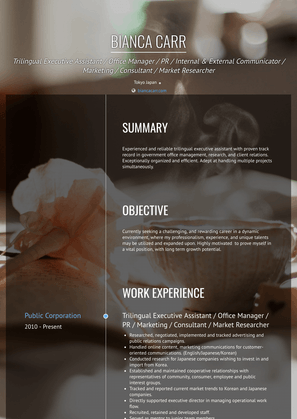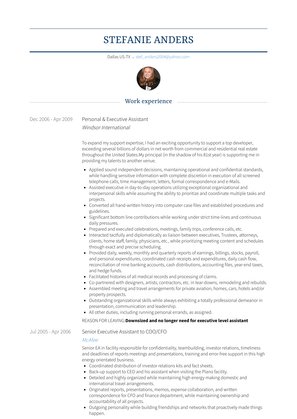Executive Assistant Resume Samples [+ 2 Examples]
This page provides you with Executive Assistant resume samples to use to create your own resume with our easy-to-use resume builder. Below you'll find our how-to section that will guide you through each section of a Executive Assitant resume.




How to Select the Right Executive Assistant Resume Template
Using a template to create your executive assistant resume means you won't have to worry about formatting the structure of your resume. You’ll be able to focus entirely on what you bring to the position, and hiring managers won’t be put off by any unusual formatting.
Companies often use ATS to track and filter their applicants. While this is a great benefit to employers, prospective employees are often frustrated that their customer service resumes aren’t even being looked at by hiring managers. Thankfully, VisualCV’s professionally designed resume templates have been specifically optimized for ATS software.
Note: Leverage AI to level-up your resume - Try our AI Resume Builder
Executive Assistant Functional Resume Format - When to use
A functional resume, also known as a skills-based resume, focuses on your skills rather than your work history. Instead of the traditional reverse-chronological resume, when creating a functional resume you choose the most relevant skills and responsibilities from your previous jobs and combine them to demonstrate your potential as an employee.
In theory, a functional resume should work well for executive assistant resumes, because it allows you to demonstrate those all-important organizational and time-management skills. However, functional resumes have a bad reputation amongst hiring managers, and most of the time your chances will suffer when you use a functional resume. Unless the job posting specifically requests a functional resume, it’s best to stick with more traditional formats.
Writing the Perfect Executive Assistant Resume Summary (with Examples)
Your executive assistant resume summary should be to the point. Focus only on the traits and experiences you have that you feel best qualifies you for the position. Speak briefly about your experience, especially if you have many years of experience to draw from, and explain why you would be an asset to the company to which you’re applying. This is a great opportunity to bring up keywords from the job posting – not only will they draw the attention of a hiring manager, they’ll likely also help you get past ATS software.
Executive Assistant Resume Summary Example
Reliable trilingual executive assistant with a proven track record in government office management, research, and client relations. Exceptionally organized and efficient. Adept at handling multiple projects simultaneously.
Experienced Executive Assistant Resume Summary Example
Accomplished administrative professional with over 15 years of experience supporting C-Level executives in complex international organizations. Poised and competent, able to exercise independent judgement under pressure always providing a sense of calm. Effectively managed across cultures with diplomacy and tact. Experienced working with highly sensitive materials and around confidential negotiations (IPO, mergers). Talent for quickly mastering technology.
Executive Assistant Resume Summary Example
Executive Assistant with 3+ years of working with CEOs, COOs of fast paced corporate environments. Won top emerging talent for 3 years consecutively by group CEO at ACME.
Related: Our guide on how to write a resume summary.
What is a good objective for a resume for an executive assistant resume?
Resume objectives differ from resume summaries – instead of writing an overview of your experience, an executive assistant resume objective introduces you and tells managers about the role you’re hoping to land. If you already have experience as an executive assistant, skip this section entirely – it won’t be relevant and it’ll only take up space in your resume. You should only include a resume objective if you’re applying for an entry-level position, or you’re looking to make a career transition using skills you gained in a different field.
Executive Assistant Resume Objective Sample
Office manager with 5 years of experience in a client-facing role looking to leverage my organizational expertise as I transition into an executive assistant career.
How to List Your Executive Assistant Experience on Resume
This is where you can really start bragging. Alison Green, author of Ask a Manager, highlights the single biggest resume mistake she saw in her time as a hiring manager: “Writing a resume that reads like a series of job descriptions.”
“The bullet points they use to describe what they did for each job just list activities and read like a job description for the role might,” she says. “For example, ‘edit documents,’ ‘collect data,’ or ‘manage website.’”
Did you ever fix an organizational mess for your boss? Have your previous managers called you a “life-saver” time and again? Now is the time to make this known to recruiters.
Executive Assistant Resume Example
Executive Assistant to VP of Public Safety & Privacy, Yellowstone Club | 2015-Present
- Managed PSP special events calendar for VP and Executive Officer
- Managed contractor’s insurance on Yellowstone Club property
- Managed HR and provided support for PSP Department
- Oversaw financial accountancy and policy creation and management
Experienced Executive Assistant Resume - Job Description Sample
Personal & Executive Assistant, Windsor International | 2006-2009
- Assisted executive in day-to-day operations utilizing exceptional organizational and interpersonal skills while assuming the ability to prioritize and coordinate multiple tasks and projects.
- Converted all hand-written history into computer case files and established procedures and guidelines.
- Significant bottom line contributions while working under strict timelines and continuous daily pressures.
- Prepared and executed celebrations, meetings, family trips, conference calls, etc.
- Interacted tactfully and diplomatically as liaison between executives, trustees, attorneys, clients, home staff, family, physicians, etc.
C-Level Executive Assistant Resume Example - Work Experience
Chief of Staff/Executive Assistant to President & CEO, Lawrence General Hospital | 2015-2016
- Advised and supported the President and CEO in all matters concerning institutional governance and relationships with the leadership of the hospital. Served as a resource of information to the CEO, Board of Trustees, and Executive Leadership.
- Managed administrative office staff in day to day operations for the Office of the President, responsible for performance and development of direct and indirect reports within the administrative function.
- Managed CEO-initiated special projects ranging from specific board requests to activities impacting company culture, translating their vision into required product, often confidential and time-sensitive in nature
- Responsible for setting and balancing agendas, collaboratively creating executive level content and presentations to ensure participants are prepared in supporting management’s strategic initiatives.
Executive Assistant Resume Work Experience Example
Executive Assistant
- Generated business proposals, prepared client agreements, presentations and other corporate documents.
- Report payroll information for 58 full-time and part-time employees.
- Provide administrative support to the Director, Business Management and other corporate staff including Director, Global Logistics, managing schedules and overseeing event schedules.
- Assisted the Executive hiring process by screening resumes and shortlisting prospective executives for scheduling interviews.
Executive Assistant Resume Experience Example
Executive Assistant
- Worked with the MD and created business proposals, presentations and co-ordinated all C-level communication.
- Co-ordinate executive tasks with department heads and ensure a smooth ongoing workflow.
- Led the implementation of new organization wide SOPs in close collaboration with the COO that resulted in 10% cost reduction.
- Launching marketing campaigns by creating copy, finalizing creatives, & managing subscriber email lists.
Top Executive Assistant Resume Skills in 2025
The more information you can provide a potential employer with about your skills, the better! The skills section of your resume is often combed by ATS to determine whether you’d be a good fit for the role. It’s the perfect opportunity to customize your resume for the position to which you’re applying – find the skills you possess on the job description and make sure those skills appear on your executive assistant resume.
Here are just a few skills employers will be on the lookout for when you apply for executive assistant jobs.
- Multitasking
- Ability to prioritize
- Organization
- Attention to detail
- Verbal and written communication
- Empathy
- Discretion/confidentiality
- Time management
- Data entry
- People skills
- Problem-solving
- Decision-making
- Composure
- Event coordination
- Adaptability
Project Management Skills for an Executive Assistant Resume
Highlight your ability to manage and execute projects efficiently, a critical skill for executive support roles.
Examples to Include:
- “Coordinated a company-wide software implementation project, ensuring timely completion and user adoption.”
- “Organized and managed the annual corporate retreat, resulting in a 20% increase in employee satisfaction.”
Technical Proficiency to Feature on an Executive Assistant Resume
Showcase your expertise in advanced software and tools that enhance executive productivity.
Key Tools to Highlight:
- Customer Relationship Management (CRM): Salesforce, HubSpot
- Project Management Software: Asana, Trello, Microsoft Project
- Advanced Microsoft Office Skills: Excel (Pivot tables, VLOOKUP), PowerPoint, Word
Example Entry: “Proficient in Salesforce for managing executive client interactions and generating custom reports.”
Multilingual Skills on an Executive Assistant Resume
Fluency in multiple languages can set you apart, particularly in international or multicultural workplaces.
Example Entry:
- “Fluent in Spanish and French, enabling effective communication with global clients and stakeholders.”
Budgeting and Financial Management for an Executive Assistant Resume
Demonstrate your ability to handle financial responsibilities and ensure cost-effective operations.
Examples to Include:
- “Managed departmental budgets, reducing annual expenses by 10% through cost optimization strategies.”
- “Prepared and presented monthly financial reports to executives, ensuring accuracy and timeliness.”
Crisis Management Skills for an Executive Assistant Resume
Employers value executive assistants who can handle unexpected challenges with professionalism and efficiency.
Examples to Highlight:
- “Coordinated executive travel changes during last-minute cancellations, minimizing disruption to key meetings.”
- “Implemented emergency protocols during office closures, ensuring continuity of operations.”
Certifications to Enhance Your Executive Assistant Resume
Certifications demonstrate your commitment to professional development and add credibility to your resume.
Key Certifications:
- Certified Administrative Professional (CAP)
- Project Management Professional (PMP)
- Microsoft Office Specialist (MOS)
Example Entry: “Certified Administrative Professional (CAP): Demonstrated excellence in executive-level support and organizational management.”
Remote Work Experience for an Executive Assistant Resume
Highlight your adaptability to modern work environments, including remote and hybrid settings.
Examples to Include:
- “Managed executive calendars and communications seamlessly in a remote work environment.”
- “Organized virtual meetings across multiple time zones, ensuring effective participation and follow-ups.”
Achievements to Highlight on an Executive Assistant Resume
Quantify your achievements to showcase the impact of your contributions.
Examples:
- “Reduced meeting preparation time by 30% through the implementation of streamlined scheduling tools.”
- “Increased client satisfaction scores by 15% by improving communication protocols.”
Community Engagement and Networking on an Executive Assistant Resume
Involvement in professional organizations can showcase your proactive attitude and dedication to the role.
Examples to Mention:
- Member, International Association of Administrative Professionals (IAAP)
- Regular attendee of executive assistant webinars and conferences
- Organizer of networking events for administrative professionals
-
Writing the Perfect Executive Assistant Resume Summary (with Examples)
-
What is a good objective for a resume for an executive assistant resume?
-
Technical Proficiency to Feature on an Executive Assistant Resume
-
Budgeting and Financial Management for an Executive Assistant Resume
-
Community Engagement and Networking on an Executive Assistant Resume
Copyright ©2025 Workstory Inc.
